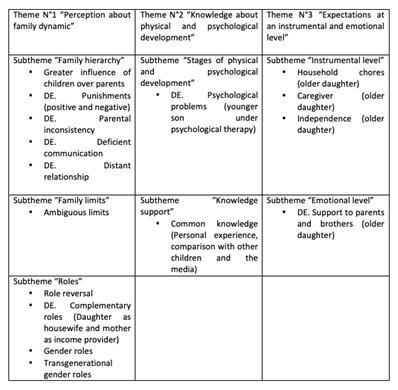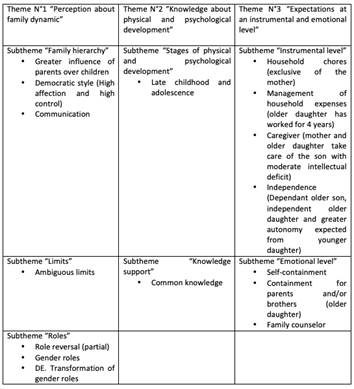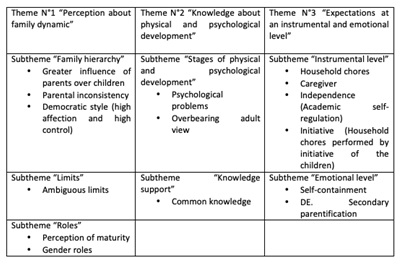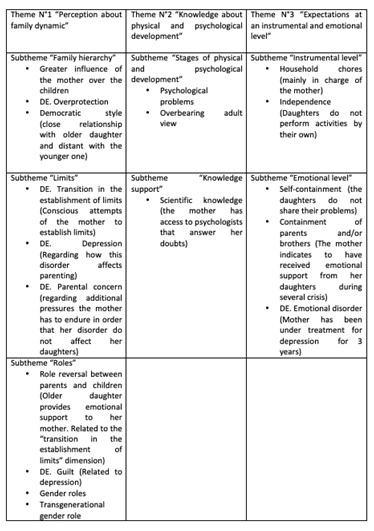Serviços Personalizados
Journal
Artigo
Links relacionados
Compartilhar
Ciencias Psicológicas
versão impressa ISSN 1688-4094versão On-line ISSN 1688-4221
Cienc. Psicol. vol.13 no.2 Montevideo dez. 2019 Epub 01-Dez-2019
https://doi.org/10.22235/cp.v13i2.1891
Original Articles
Parentification in single-parent families
1 Escuela de Psicología, Universidad del Bio Bio, Chile ps.carmendominguez@gmail.com, diegogozalez8@gmail.com, danitza.navarrete.2017@gmail.com, nzicavo@ubiobio.cl
Key words: parentification; single-parent family; household chores; limits; roles
Palabras clave: parentalización; familia monoparental; tareas del hogar; límites; roles
Introduction
According to the classification given by UNICEF (2000), it is possible to classify the parentification phenomenon as a type of emotional negligence because, since the moment a child receives a task that exceeds his or her physical and/or emotional capabilities, the parent or caregiver is necessarily ignoring which are the real capabilities the child has according to his or her age. However, unlike other types of negligence or mistreatments, this phenomenon tends to be hidden in order to maintain the family balance. As an example, this happens when a parent, for work purposes, has no one to look after the children, and therefore, the older child is left in charge of the younger ones. In this case, the child performs functions related to the parent, obtaining the benefit of being recognized for the “help” given to his or her parents or caregivers, who also benefit from the tasks performed by the child.
Among the different family conformations, single-parent families are more vulnerable to the presence of this phenomenon (Jurkovic, Thirkield and Morrell, 2001; Peris and Emery, 2005; quoted in Blazek, 2016) since there is only one adult who performs the household chores which in other family structures are carried out by two or more people, making the children more likely to adopt the missing roles in the family. This is important since, according to the data obtained from the National Social and Economic Survey (2015 CASEN survey), nuclear single-parent families represent 14.5% of the total number of households, of which, 13% are headed by females, and 1.6% by males. For these reasons, this research is focused on single-parent families.
The present article allows determining possible actions to be taken in order to improve interventions in families with parentified children, as well as to give a warning about preventive actions that could be needed.
Family, Limits, Parentification, Subsystems, Single-parenthood
The parentification concept was defined for the first time by Minuchin et al. in 1967 (quoted in Hooper and Wallace, 2009), and it means that parents resign their functions and leave the children in charge of them, or completely leaving their family in a psychological and/or physical way. Parentification is understood as assigning parental roles to one or more children of a family system or the assumption of that role by one of them. Espina and Pumar (1996) indicate that children to escape from their stage of development, but also express the need and hope for change, taking responsibilities for which they are no ready at the expense of their own emotional development. From a systemic point of view, there are two factors present in parentification, the first correspond to specific patterns in which children are expected to fulfill the emotional needs from their parents, and the second is related to additional situations that increase the emotional needs of parents for not receiving enough support from their spouse.
As we go deeper in the previously mentioned matter, according to Espina and Pumar (1996), reverse parenting happens in parents with unresolved emotional needs and who perceive their own parents as cruel and/or uncaring. The theory of Bowen (Rodríguez-González and Martínez, 2015) speaks about multigenerational transmission, being the emotional problems of the family system the result of that transmission. Therefore, as these authors expose, it is important to consider the personal experience of the parents, however, Bowen allows us to glimpse even the influence of previous generations.
Parentification can emerge as a response to the way family subsystems are delimited by both, rigid limits in the marital subsystem (Gunderson, Kerr and Englund 1980, quoted in Jurkovic, 1997), and ambiguous limits between the parental subsystem and the children (Kerig, 2005 quoted in Hooper, L'Abate, Sweeney, Gianesini, Jankowski, 2013).
There are two different types of parentification: instrumental and emotional. The first one implies that the child is left in charge of the household chores such as shopping, household managing, cooking, cleaning, etc. (Hooper, 2007 quoted in Engelhardt, 2012). This type is the less harmful, it increases the feeling of achievement and competence when parents encourage such conducts (Aldridge, 2006; Hooper, 2007 quoted in Engelhardt, 2012). On the other hand, in emotional parentification the child provides the parents with emotional support, which fulfills their psychological needs in situations of stress or crisis. This represents a greater risk for the child as he or she is not developmentally ready for this task (Hooper, 2007 quoted in Engelhardt, 2012).
According to the characterization exposed by Blazek (2016), the apparition of the parentification phenomenon is possible in single-parent families (Jurkovic, Thirkield and Morrell, 2001; Peris and Emery, 2005), as well as when one or both parents suffer from chronical diseases (Stein, Riedel&Rotheram-Borus, 2004; Duryea, 2007; Tompkins, 2007; Wallerstein, 1985), or the same happens with the brothers or sisters (Oznobishin and Kurman, 2009), among others.
If we observe the parentification process as a continuum, it is possible to establish that all the family members have been exposed to such process to some extent (Williams, 2010). However, this turns into a problem in many situations, for example, when children are left in charge of excessive responsibilities that surpass their capabilities according to their developmental level; when parents or caregivers are negligent and do not consider what is best for the child; when the child is not entitled in his or her role and when parents play a childlike role (Mika, Bergner, and Baum, 1987 quoted Williams, 2010).
Another factor to be considered and that allows us to distinguish between a parentification with negative results from the one that can be better tolerated by children, is the one that temporarily emerges while the family system adapts to the stressors or the changes that must face, for example, in a divorce situation, the death of one of the family members, etc. (Jankowski, Hooper, Sandage and Hannah, 2011).
Selvini, Boscolo, Cecchin and Prata (1991) state that parentification can be functional for a child, however, it depends on the transactional context in which parentification appears. Children can practice and learn from this role when this is not exchangeable and not rigidly assumed.
Empirical Framework
According to the study about cultural models of parenting in Chile “Modelos culturales de crianza en Chile” (Universidad de Chile, World Vision, 2018), it is observed that the predominant household composition is the two-parent nuclear family (49.9%), followed by extended families (mother, father, children and other relatives, with 16.1%), and in third place single-parent families with female household heads (14.1%). This study do not quantifies single-parent families with male household heads, maybe because the percentage is very low compared with the female percentage. However, this research allows us to glimpse how relationships between parents and children are configured, including as well other relationships that children establish with other significant adults that live in the household. It can also be inferred that the care of children is still very related to the female gender, being the mother the first to correct or teach, and also being the one who the children turn to when feeling in trouble or sad. In 42.4% of the sample, the mother is the one who disciplines and provides emotional support; 13.2% pointed out that it was the father who corrected them and the mother who provided emotional support; 11.5% stated that the mother plays a disciplinary role and the father provides emotional support; and in 11% of the cases the mother provided discipline but had no one to turn to when emotional support was needed. It is important to note that this last configuration can be showing parentification, since it not only happens when the child must provide emotional support to other family members, but also when he or she must emotionally support him or herself. In single-parent families with female household heads, the configuration of the mother that disciplines but no one providing emotional support increases to 15.6%, which is consistent with the studies about parentification pointing to single-parenthood as one of the intervening factors.
As mentioned in Panorama CASEN. Households and Well-Being: Analysis of changes in the family structure (2015). Of the total number of households in Chile, 14.5% correspond to single-parent families, of which 13% are headed by females and 1.5% by males.
Regarding the demographic area to which the studied families belong, the CENSUS (National Statistics Institute (INE), 2017) showed that in the Ñuble region exist 21.924 single-parent nuclear families which represent 13.4% of the total number of households in the region.
Materials and Method
This research follows the phenomenological paradigm, which understands knowledge as a process of pure immanence. The objective of the phenomenological studies is to better understand the experiences of the investigated persons, including four essential factors for that purpose: temporality, spatiality, corporeality and communality. All this locates the individual in a context that explains and contains conduct, which makes sense only in relation to this context (Álvarez, 2003).
The study used a qualitative approach which focused on “the understanding of a reality considered from its particular aspects as a product of an historical construction and viewed from the logic and sense of its protagonists, in other words, from an internal perspective” (Pérez, 2001; quoted in Quintana and Montgomery, 2006. p. 48). A rhombus or diamond design was used in order to carry out both an analytical and synthetic process. The design of this research is flexible, non-experimental and cross-sectional, since the gathered data correspond to a fixed time period. The semi-structured interview was used as data gathering technique, which is characterized for having a list of subjects or questions to be addressed that are randomly introduced and as a conversation (Corbetta, 2007).
The sample consisted of 4 single-parent families with a female head of household and with at least one of the children under 18 years of age. All these families are residing in the city of Chillán, Chile. The participants of this investigation were contacted through the Psychosocial Center from the city of Chillan, which is an institution that depends on Universidad del Biobío and provides free psychological care.
First of all, a preliminary interview was carried out with the female heads of household in order to avoid non parentified families and to gather data about the genogram. Afterwards, a semi-structured interview was done with an average length of one hour in order to inquire about family dynamic characteristics. An open interview was conducted with a key informant for the purpose of triangulating the obtained data. At the end of this stage, a data analysis was carried out as described below.
Data analysis, ethical and quality criteria
A content analysis was used, which is characterized for being an “empirical approach of methodologically controlled analysis of texts inside its contexts of communication, following step by step the analytical rules of content and models, without quantification” (Mayring, 2000 quoted in Cáceres, 2003, p. 56).
As previously mentioned, a rhombus or diamond design was used, for which it was first necessary to deconstruct the subject of study by a review of the available literature. Subsequently, a framework of reference was developed as a guide for the operationalization of the phenomenon to be studied, in other words, “the definition of the instruments, the identification of the units to be observed and the attributes of the analysis units” (Henríquez and Barriga, 2005, p. 165).
The operational construction is found between the previously mentioned development of analysis and the synthetic stage. In this research, codification was used as a way to transform information into data, considering the constructs found in the framework of reference, while including emerging codes of the experiences gathered. Following what is exposed above, the codes were related and organized in order to reconstruct the deconstructed subject of study (Henríquez and Barriga, 2005).
The last stage included the synthetic process, which implied an interpretation of the obtained data guided by the framework of reference in order to fulfill the objectives proposed by this investigation, which in this case were to know, identify, inquire and describe (Henríquez and Barriga, 2005).
The quality criteria were safeguarded by the triangulation between investigators, the triangulation of theory, and the critical judgment of the academic advisor, besides the use of the “clarification” verbal technique during the conduction of the interviews, all of these in order to confirm that the investigators fully and truthfully understand what is being expressed by the interviewed. At the same time, the dependence criterion is evidenced by the assessments with the thesis supervisor, which ensures a proper development of the research process.
Regarding ethical criteria, according to what is stated by González (2002), this research presents clinical and social value, since it contributes to the deconstruction of prejudices about families with parentified children and to take a more comprehensive look at this phenomenon, besides the creation of a space for the learning and development of parenting skills for the parents of these families. Scientific validity is given by the proper realization of a project, which involved internal and external supervision in every stage of this process. In addition, the participants were equally chosen using the methods described in the methodology. Once the results of this research were obtained, each of the interviewed mothers received psychoeducation about parentification and stages of human development. All of the foregoing was safeguarded by an informed consent that was written and signed.
Results
The results of the 4 studied families are shown bellow, condensed in summary tables in which can be found the themes and Subthemes of this research, as well as the corresponding a priori and a posteriori dimensions with the prefix “DE.” for an emerging dimension, and which corresponds to the specific dimensions of the family under consideration.
Family 1
Family N°1 is made of the mother and her two children, D. (18 years) and J.P. (7 years). The family income is earned from the formal work of the female household head and her side jobs. For this reason she spends little time in the house (Figure 1).
Family 2
Family N°2 is made of the mother and her three children, F. (26 years), V. (18 years) and C. (10 years). Family income is provided by pensions received by the mother for her children, including the disability pension of F., who is diagnosed with Moderate Intellectual Deficit (Figure 2).
Family 3
Family N°3 is made of the mother and her daughter, L. (6 years). Despite the fact that the mother states that she lives with her partner and her brother, in any moment these people assume care of L. On the other hand, the mother said anything about how family income was provided. Nowadays, she has been unemployed for one month and a half (Figure 3).
Family 4
Family Nº 4 is made of the mother and her two daughters, C. (14 years) and R. (11 years). Family income is obtained from the work of the mother (Nursing technician) (Figure 4).
It is necessary to clarify that due to the number of studied families, and being consistent with the phenomenological characteristics of a research, the obtained results in the study are summarized in this article and correspond only to the studied families and their particular characteristics; therefore, these results are not representative or applicable to other families.
Conclusions
The parentification process responds to the specific needs of each family system, which suggests that the emergency of a specific type of parentification will be mainly given by the characteristics of the specific needs of each family, as well as by the parenting style and skills. Therefore, it can be concluded that:
For family N°1, parentification is a phenomenon that provides family balance, causing the assumption by the children of the chores that the mother cannot do towards the household or her children. This allows the mother to focus on other relevant tasks for the system like the earning of greater economic income. Parentification emerges as a response to the lack of support networks to rely on at an instrumental and emotional level. For this reason, the style of parentification observed in this family corresponds to a mixed type. Such parentification appears as a response to complementary roles, in which the mother plays the role of “provider” and the daughter the role of “mother - housewife”. This is consistent with what is explained in the structural model, which states that complementary roles appear between the family members as a response to transactional guidelines, and it is related to the expectations and demands between them (Moreno, 2015).
In the case of family Nº2, an emotional and instrumental parentification was observed, which can be appreciated both in the demands and expectations of the female household head on her daughters. In the emotional level this is translated as the support that she must provide to the daughters according to her. The phenomenon satisfies the lack of supportive networks to rely on, situation that is pointed out by Barudy (2009) as a relevant factor when parentification appears in families, since all the problems must be solved inside the family system, which in the case of single-parent families with ambiguous limits, implies a greater participation of children in these solutions.
Regarding family Nº3, it is shown a parentification of emotional type, since the mother believes that the daughter should emotionally contain herself, and so, getting more time to perform other labors. On the other hand, in this particular case is observed that the mother (who was parentified during her childhood) repeats this parenting process with her daughter, which we will label as secondary parentification. This term is used to refer to the phenomenon that meet the characteristics of parentification, but do not responds to any actual need of the family system, therefore, it represents a repetition of the parenting patterns used in the family of origin of the parents, which in the case of single-parent families seems to be easier to identify, since there is only one point of view regarding parenting styles.
Finally, in the case of family Nº4 is observed an emotional parentification that emerges as a result of the conflictive divorce which ended the marriage relationship and of the depressive disorder currently suffered by the female household head. This is related to what is mentioned by Hooper (2007, 91 quoted in Engelhardt, 2012), regarding the appearance of emotional parentification to provide the parents with emotional support in order to meet their psychological needs in situations of stress or crisis. In this sense, emotional parentification contributes to the family subsystem since it allows the mother to satisfy her need for containment regarding the conflicts she maintains with her ex-husband and the very symptoms of depressive disorder. This situation is aggravated by the lack of supportive networks that the mother relies on.
Considering the results observed and the conclusions derived from them, it can be concluded that parentification is a process that, even though has different origins; normative and non-normative crisis, family history, among others; it always results in a way to achieve family balance. Due to the fact that the system benefits from this, it tends to hide the phenomenon, even in situations when can be pathological or harmful for a correct development of the children, who have to sacrifice themselves for the functionality of the system.
Suggestions for future investigations
Children should be integrated in the research since through their testimony one can access into the way they perceive parentification and how this phenomenon affects them, in order to have a panoramic view of all the family subsystem.
Single-parent families with a male household head should be included in order to study the differences that could exist between them and those with female household heads.
A wider sample should be used in order to generalize the results.
REFERENCES
Álvarez, J. (2003). Cómo hacer investigación cualitativa. México D.F: Paidós. [ Links ]
Barudy, J. (2009). Los buenos tratos a la infancia: parentalidad, apego y resiliencia. Barcelona: Gedisa. [ Links ]
Blazek, M. (2016). Parental attitudes and parentification of children in families with limited parental care competencies. Polish Journal of Applied Psychology, 14(3), 93-107. Doi:10.1515/pjap-2015-0064 [ Links ]
Cáceres, P. (2003). Análisis de contenido cualitativo: una alternativa metodológica alcanzable. Psicoperspectivas, individuo y sociedad. 2(1), 53-82. Recuperado de http://www.psicoperspectivas.cl/index.php/psicoperspectivas/article/viewFile/3/3 [ Links ]
Corbetta, P. (2007). Metodología y Técnicas de la investigación social. Madrid: McGraw-Gill. [ Links ]
Encuesta de caracterización socioeconómica (CASEN). (2015). Hogares y bienestar: Análisis de cambios en la estructura de los hogares (1990-2015). Recuperado de http://observatorio.ministeriodesarrollosocial.gob.cl/documentos/Panorama_Casen_ 2015_Hogares_y_bienestar.pdf [ Links ]
Engelhardt, J. (2012). The Developmental Implications of Parentification: Effects on Childhood Attachment. Graduate Student Journal of Psychology. 14, 45-52. Recuperado de: https://www.tc.columbia.edu/publications/gsjp/gsjp-volumes-archive/gsjp-volume-14-2012/25227_Engelhardt_Parentification.pdf [ Links ]
Espina, A., Pumar, B. (1996). Terapia familiar sistémica: teoría, clínica investigación. España: Fundamentos. [ Links ]
Fondo Internacional de Emergencia de las Naciones Unidas para la Infancia (UNICEF, por sus siglas en inglés) . (2000). Maltrato infantil en Chile. UNICEF responde. [ Links ]
González, M. (2002). Aspectos éticos de la investigación cualitativa. Revista Iberoamericana de Educación, (29), 85-103. [ Links ]
Henríquez, G. y Barriga, O. (2005). El Rombo de la Investigación. Cinta de Moebio, (23), 162-168. Recuperado de http://www.facso.uchile.cl/publicaciones/moebio/23/henriquez.htm [ Links ]
Hooper, L. M., L'Abate, L., Sweeney, L. G., Ganesini, G. y Jankowsk, P. J. (2013). Models of Psychopathology: Generational Processes and Relational Roles. New York: Springer. [ Links ]
Hooper, L. y Wallace, S. (2009). Evaluating the Parentification Questionnaire: Psychometric Properties and Psychopathology Correlates. Contemporary Family Therapy, 32(1), 52-68. doi 10.1007/s10591-009-9103-9 [ Links ]
Instituto Nacional de Estadísticas Chile (INE) . (2017). Censo de Población y Vivienda 2017. Recuperado de http://ine.ine.cl/redbin/RpWebEngine.exe/Portal?BASE=CENSO_2017&lang=esp [ Links ]
Jankowski, P., Hooper, L., Sandage, S. y Hannah, N. (2011). Parentification and mental health symptoms: mediator effects of perceived unfairness and differentiation of self. Journal of Family Therapy, 35(1), 43-65. Recuperado de http://guru.louisville.edu/hooperresearchlab/uploads/1/8/9/9/18990313/37.-journal- of-family-therapy-2012.pdf [ Links ]
Jurkovic, G. J. (1997). Lost Childhoods: The Plight of the Parentified Child (Infancias Perdidas: La difícil situación del niño parentalizado). Nueva York: Brunner- Routledge. [ Links ]
Moreno, A. (2015). Manual de Terapia Sistémica. Bilbao: Desclée de Brouwer. [ Links ]
Quintana, A. (2006). Metodología de investigación científica cualitativa. En A. Quintana y W. Montgomery (Eds.). Psicología: Tópicos de actualidad. Lima: UNMSM. [ Links ]
Rodriguez-Gonzalez, M. y Martínez, M. (2015). La teoría familiar sistémica de Bowen: avances y aplicación terapéutica. Madrid: McGraw-Hill. [ Links ]
Selvini, M; Boscolo, L., Cecchin, G. y Prata, G. (1991). Paradoja y contraparadoja. Buenos Aires: Paidós [ Links ]
Universidad de Chile y World Vision (2018). Modelos Culturales de Crianza en Chile: Castigo y ternura, una mirada desde niños y niñas. Chile. Recuperado de https://www.worldvision.cl/modelos-culturales-de-crianza-en-chile?hsCtaTracking=18b52918- db23-402d-9217-f724ef103c2c%7Ce945d4ca-f512- 4948-9164-6eaa62b65390 [ Links ]
Williams, K. (2010). Examining the Construct of Childhood Parentification: An Empirical Investigation. (Tesis de maestría). Memorial University of Newfoundland, St. John. Recuperado de https://core.ac.uk/download/pdf/33557476.pdf [ Links ]
Note: Authors' participation: a) Conception and design of the work; b) Data acquisition; c) Analysis and interpretation of data; d) Writing of the manuscript; e) Critical review of the manuscript. C.D. has contributed in a,b,c,d, e; D.G. in a, b, c, d, e; D.N. in a, b, c, d, e; N.Z. in a, b, c, d, e.
Correspondence: Carmen Domínguez A. Email: ps.carmendominguez@gmail.com, Diego González S. Email: diegogozalez8@gmail.com, Danitza Navarrete J. Email: danitza.navarrete.2017@gmail.com, Nelson Zicavo M. Email: nzicavo@ubiobio.cl.
Received: March 19, 2019; Accepted: July 23, 2019











 texto em
texto em 







